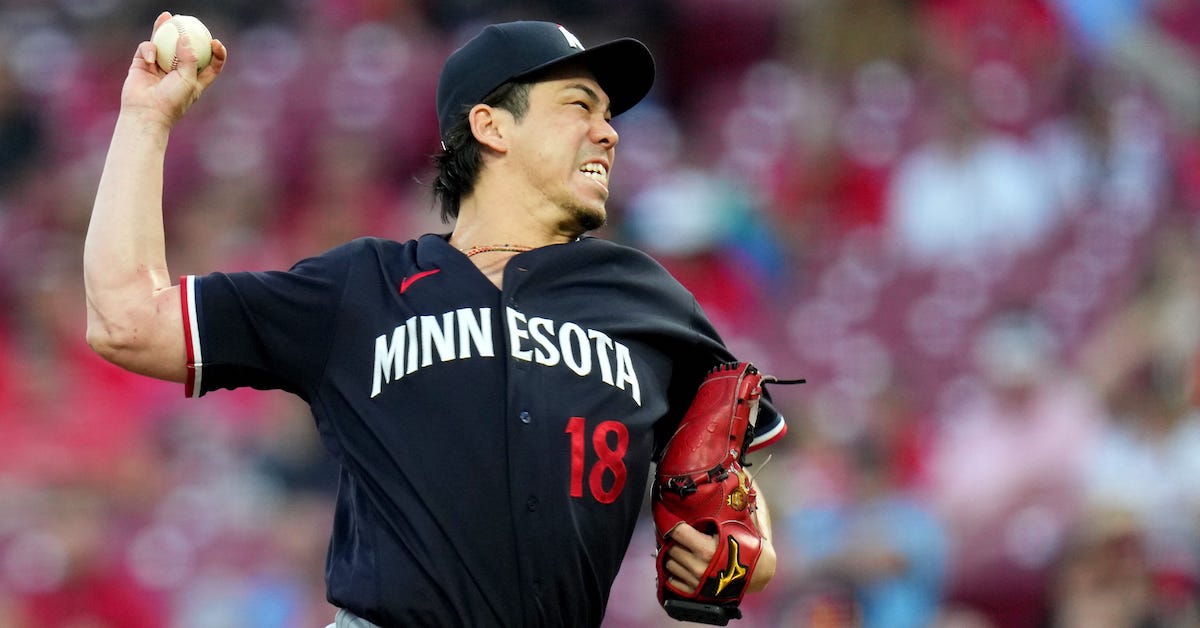Kenta Maeda on Evolving as a Pitcher

Kenta Maeda has had a stellar career on two continents. Now in his seventh big league season — three with the Minnesota Twins preceded by four with the Los Angeles Dodgers — the 35-year-old erstwhile Hiroshima Carp has a 2.95 ERA and a 162-115 won-lost record between NPB and MLB. He’s been as good as ever in September. The Osaka native has been credited with a win in each of his last three decisions while allowing just four runs over 17-and-two-thirds innings. When he next takes the mound it will be with a 4.28 ERA and a 3.96 FIP on the year.
Maeda discussed his evolution as a pitcher, and offered some thoughts on NPB, when the postseason-bound Twins visited Cleveland earlier this month. Daichi Sekizaki served as an interpreter for the interview.
———
David Laurila: How much have you changed as a pitcher since coming over from Japan?
Kenta Maeda: “The first couple of years I was pretty much just myself; I was the same pitcher that I was in Japan. After pitching here for several years, I know what the different hitters’ weaknesses are and when they are getting on to me. I ironed some things out and made adjustments to become better, to become the pitcher that I am today.”
Laurila: What were your most notable adjustments?
Maeda: “I incorporated the trend that was here. Early on, I was very two-seam heavy. Gradually, I became more four-seams up, which is an effective pitch. So it was about the trend of pitchers throwing certain pitches, and hitters being able to make contact, or not make contact, on certain pitches. I played that game a little bit.
“I also altered my changeup. The one I had before, a circle changeup, wasn’t effective enough, so I made it into a split-change. I’d always wanted to throw a splitter, but I was never able to get comfortable with one. So I had the circle, but because it wasn’t effective… instead of throwing something I couldn’t throw, I played around with different grips and found the current grip, which works fine.”
Laurila: What, specifically, is the current grip?
Maeda: “Instead of a two-finger split, it’s a three [with the ring and middle fingers together]. I was never able to throw a two-finger split, and one day during a game I was kind of playing around with a ball. I decided to move the fingers this way and see what it did to the ball. From there I found the grip. It mostly gets depth, but also some fade.”
Laurila: Is there a specific pitch that worked well in NPB and not as well here in MLB, or vice versa?
Maeda: “I don’t think there is a definitive, specific pitch that works well against… and obviously, pitchers pitch against hitters. There isn’t one cookie-cutter pitch that is effective in one league and not effective in the other.”
Laurila: Have you changed at all mechanically? For instance, if I compared film of you in Japan to now, would I see the same delivery?
Maeda: “It would probably be different. I think that has to do with developing as a player; different body physiques, age. Those impact mechanics. Even if I were still in Japan — if I’d never come over here — I would have the same mechanics that I do today. My body has adapted.”
Laurila: How much attention do you pay to analytics?
Maeda: “It depends. If I’m pitching well, I just let it be. If there’s something wrong, I might do some digging. It depends on the situation.”
Laurila: How does the availability and usage of data in NPB compare to here?
Maeda: “I want to say that the United States has more data available, but then again, it’s been eight years since I came over. And in those eight years, from my rookie season here to now, there is more data available. So, it’s hard to say how much the Japanese league has developed over that time. But probably America has more.”
Laurila: Do you plan to pitch in Japan again some day?
Maeda: “I’m not sure yet.”
Laurila: If you do, will you pitch any differently than you did before coming here?
Maeda: “It’s really tough to say. Being there and pitching in that league, the hitters are different. And again, I have a somewhat different arsenal now. In that regard, things might change. But again, it’s hard to say at this point.”
Laurila: How much are you currently following NPB?
Maeda: “I read box scores and follow what is written by the media there.”
Laurila: Are there any NPB pitchers you’d compare to Kenta Maeda? Not so much at your current age, but rather when you were the age they are now?
Maeda: “No clue.”
Laurila: What about Yoshinobu Yamamoto?
Maeda: “He’s a great pitcher. He’s probably way better than me. I mean, it’s hard for me to say if a pitcher is better than me, or not as good as me, but he’s a well-established pitcher. That’s all I can really say. But again, he’s probably better.”
David Laurila grew up in Michigan's Upper Peninsula and now writes about baseball from his home in Cambridge, Mass. He authored the Prospectus Q&A series at Baseball Prospectus from December 2006-May 2011 before being claimed off waivers by FanGraphs. He can be followed on Twitter @DavidLaurilaQA.
Kenta Maeda entre 2014-15 tiró un cambio en Japón, en un 12% del tiempo. Su RV/100 fue de -0.57. Era más un lanzador de 4-Seam, Slider y 2-Seam. Ahora mismo, es algo más centrado Splitter-Slider. Y su slider en NPB tuvo rangos de valor en RV entre 19.8-32.5 en algunas temporadas.